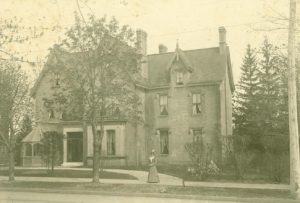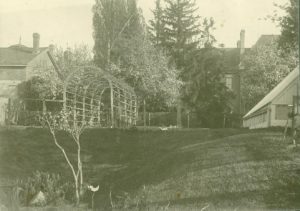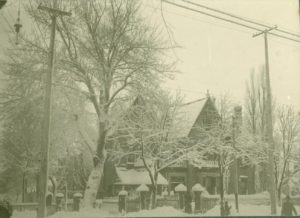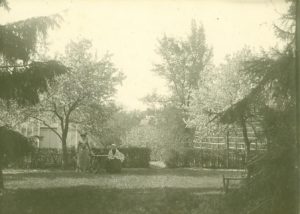Around the time Toronto’s first mayor took office, land speculators began touting a fashionable new village. Yorkville, they called it, an homage to the Brit name once bestowed on Toronto. It was beautifully situated, healthy, park-like, with limited access via tollgate. Perfect for heads of business and industry—former downtowners who had the audacity to move out of the financial district. Liberals and conservatives, civic-promoters and self-promoters who built spectacular houses on stunning high ground, then exited them each morning to trundle back down to their offices in the financial district. Who bought stock in their neighbour’s companies, attended weddings of their neighbour’s children and complimented their neighbour’s good taste.
Whose imbroglios over the years made the newspapers and whose funerals matched their celebrity, with lofty eulogies, like “The Secret of a Peaceful Life” for J.L. Blaikie, a resident of Yorkville’s Rosedale section, who partnered with his neighbour across the street, William Alexander, to establish the first brokerage on the Toronto Stock Exchange. Theirs were the funerals that closed businesses and stopped traffic with grand processions to resting places at Mount Pleasant or Mount Hope. Theirs were lives profitably spent, though neighbours who heard Blaikie’s eulogy knew full well: “The life of a business man is never free from troublous problems and harsh alarms.” Even in leafy, serene Yorkville.
One such alarm came in 1899, when three former neighbours whose backyards met at the Rosedale ravine, and six more neighbours just blocks away, went to their resting places. Rest in peace, Charles Boeckh, James W. Gale, James Graham, Joseph Harris, Bernard Hughes, Patrick Hughes, Edmund Meredith, Hugh Ryan, Charles Stark. Magnates all.
When I google Yorkville by address, my snoopy browser thinks I’m searching for a restaurant or a nail salon. But I want something more durable. Something made of red sandstone or buff brick, with knife-point gables, corner tower, portico, perhaps a conservatory. I’m searching for houses worthy of naming—commemorative names, nostalgic names like Glenhurst, Hollydene, Thistledale, Denbrae. Betitled houses that authenticated their owners’ progress from tenement to duplex to cottage to estate. Like the home of Thomas McLerie Thomson on Bloor Street East—the southern boundary of Yorkville. Bearing the house number 17 when he purchased it in 1878, renumbered 112 a decade later, climbing to 152 after another decade of in-building, settling at 278 in its final days.
The house I am searching for belonged to my three-times-grandfather-in-law. True my kinship is somewhat remote but I my affinity for the family that lived at 278 is strong. This was T.M.’s retirement home. He settled at Bloor Street East after a successful, four-decade career in merchandising in Montreal, after his six children were born and reared (three daughters and a son with his first wife and two daughters with his second wife), after his son moved to Toronto to apprentice in law. 
I wonder why Thomson chose a house on a ravine site. Perhaps the answer lies in a slim yet authoritative guidebook from his own library: “Near almost every town or village we find some beautiful natural elevations, suitable sites for residences, which, with comparatively little labor, can be brought into a state of high perfection. Nature often favors us in our work, and trees, water, and many special qualities of the ground make the work of gardening doubly interesting—such localities should be selected as sites for suburban villas.”
Such was the site selected for number 17, the villa that came to be known as Bloorview. Its heavy-browed windows looking aghast at Toronto’s race to the future, its backside cozying up to Rosedale’s plummy present. Poised between urban and rural on a long strip of land dropping to the ravine, with sufficient level ground out back for a grapery, an arbour, an orchard. And rustic cedar chairs scattered willy-nilly about the grounds, for watching finches at twilight, waving to neighbours across the divide.
It’s easy to imagine carefree children making daisy chains and tumbling on the lawn, but the Thomson daughters were beyond childhood when they moved in and the other three lived elsewhere with families of their own. Here, the daughters studied their Bibles, entertained at afternoon garden parties and took long trips to Switzerland to visit their eldest sister. Here, their mother contributed to charitable causes, gathered lilacs for the dinner table and went visiting. Here, their father spent his final years handling finances, serving on boards and attending church. It was his earnest desire, he wrote in 1881, that upon his demise his wife and unmarried daughters should continue to live together in the same house, the place of their mutual happiness.
Bloorview housed the Thomson family for twenty-five years of pleasant days and worry-free nights. Then, after the deaths of Thomson and his wife, Bloorview was sold. And it slipped into an ever more dystopian future. Here, forty children slept in the bedrooms, ate in the dining room and sat in the lawn chairs. Here, staff kept close watch on these children—these chronically ill, disabled, maimed, sick children. Here, families experienced much unhappiness. And after many years of service as the Home for Incurable Children, Bloorview was demolished, having outlived its usefulness.
The land on which Bloorview sat, however, will never outlive usefulness. Today, there are more residents on that strip of land than I can shake a stick at—a stick I’d have to yank off a maple at curbside. But I see residents on their balconies seeing me. Besides, I’ve parked next to an “Authorized Parking Only” sign and I sense I’m about to be queried by that uniformed person lurking in the doorway of the high-rise, so I reluctantly abandon the idea of searching for vestiges of the house that once sheltered Thomas M. Thomson, an earnest and quietly effectual immigrant merchant who bootstrapped his way from Paisley, Scotland to Montreal to Toronto. There’s no sign of Bloorview on Bloor East these days, only high-rises and the noise, dust and turmoil of city life.
In early days, the Village of Yorkville was proud of its pure water and healthy air, promoting itself as “a favourite place of residence for those who prefer to live away from the noise, dust and turmoil of city life.” And those who preferred were seriously affluenced, having the wherewithal to move two miles above the harbour and hoist a flag atop their very own turret. Whose names were inscribed in the Elite Directory and Club List of Toronto. Whose wealth made for an elite that was simultaneously disparate and cohesive—moderately disparate by age, descendancy, religion, and esoteric pursuits; extremely cohesive by privilege and gravitas.
It is due to such directories and etiquette books—invaluable to families of privilege at the time and now invaluable to me—that I learn the female Thomsons of Bloorview were at-home on Mondays to receive visitors and they dutifully wrote thank you letters on stationery embossed with their initials. When hostessing dinners, their table was set with their best china (from England in Thomson’s case), their damask linens were starched, and their servants served from the left of guests. One break with convention—the Thomson table did not include the usual assortment of wine glasses. The Thomsons never served wine at dinners—they were tee-totaling Baptists. And in keeping with non-ecumenical Baptist tendencies, they probably did not attend the requiem masses for the Hughes brothers, one celebrated in February, the other a month later.
Not that Bloorview was free of imbroglios. There was a minor one at the turn of the century, when the Thomsons, now minus T.M., held a long-overdue reunion. The hostess, Elizabeth Anna Sinclair Thomson, widow of the patriarch, didn’t have enough bedrooms. It’s complicated. She occupied the master and two rooms belonged to daughter Alice and step-daughter Annie Jane, though they sat empty for long stretches of time. Also taking up space was daughter Kate, just arrived from Washington, D.C., home-base for international expeditions of geologist-husband J. W. Winthrop Spencer, Ph.D., F.G.S., who brought trunks full of scholarly papers, field notes, maps, clip boards, pocket scribers and rock samples. That’s four bedrooms so far.
Step-daughter Marion, widow of the Rev. Reikie, and her three grown children had already laid claim to one wing. Seven bedrooms and counting. Expected any day was the patriarch’s eldest, Mary Ker, all the way from Lausanne with husband C.J. Way, an artist invited by Sir William Van Horne to paint the western Provinces along the CPR line. Arriving with a dozen trunks full of paints, canvases, brushes, and palettes. And who knows how many trunks of the Way daughters’ apparel, their calendar being chocked full of art exhibitions and midnight suppers.
And then there was step-son Tom with his brood. Okay, so he only lived a couple blocks west on Bloor, but you know how these reunions can turn into sleepovers. Imagine this respectable house bulging at the seams, laughter jostling pictures on the walls, and grandkids dizzily rolling downhill. It was the most exuberant house party Bloorview ever saw.
The following year, Elizabeth passed on and so did the house.
A plaque might be nice, “something plain, short and expressive, multum in parvo,” as the landscape professor advised in the guidebook once in T.M. Thomson’s library, now in my library. A plaque near the door of 278 that would lend historicity to the address and its surroundings, that would make an impression on the mind of the curious passerby. How about, On this site, in the spring of 1901, the Thomson family took tea in the arbour as cherry blossoms rained down.
Note: Photographs courtesy of the author




